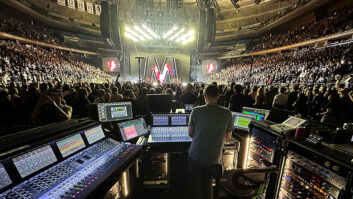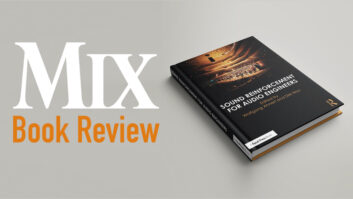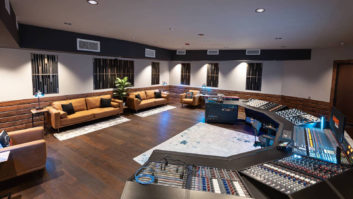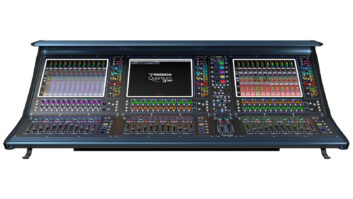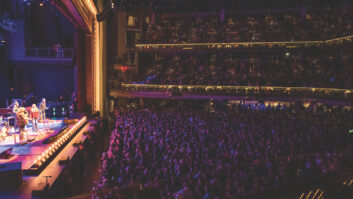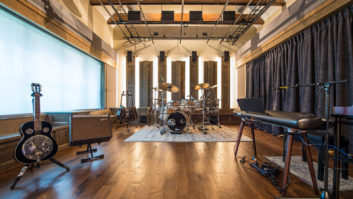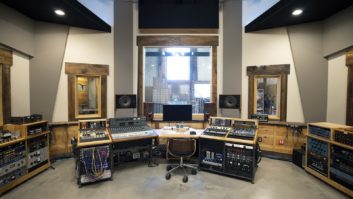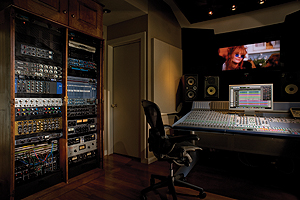
PAD was the system designer for engineer/producer Yaron Fuchs’ personal studio.
With technology changing by the minute and becoming ever more complex in some ways (but simpler in others), it’s getting harder even for seasoned audio pros to keep up with dizzying shifts and trends. Owner/operators may wonder: How do I integrate new gear into my old workflow—or should I try? What new equipment or way of working will increase my efficiency but not present too drastic a learning curve? Do I have to throw out all my analog boxes and switch to plug-ins? How can I get the most bang-for-my-buck outfitting this cool room off of my garage?
There are a few ways to answer those and other questions. Hundreds of clicks around the Internet on manufacturers’ Websites and in audio chat groups could shed some light. Perusing magazines like this one could point you in some positive directions. Or you could try the route that an increasing number of overworked and/or befuddled folks have tried: enlist the services of professional systems designers. Thousands have worked hand-in-hand with these largely unsung experts in gear selection, integration and work solutions to find the most comfortable and economical path through the new technology minefield. We recently checked in with reps from four successful firms in the system design world to learn more about what makes them tick and the range of services they offer.
PRO AUDIO DESIGN
Playing in bands, working in studios and bartending. That’s how Dave Malekpour sums up his life in the Boston area before he got involved in the world of professional audio in the mid-’80s, first as part of a local studio design, installation and maintenance concern, then as head of his own company: Anything Audio, founded in 1989, which morphed into the now-giant Pro Audio Design in 1993.

Dave Malekpour of Professional Audio Design
“The first person I hired was a tech, so it was me and him, and my concept was sales and service combined—try to connect things in a holistic way,” he says. “I’ve had this system design approach from the beginning. What does this connect to? How are you using it? What does it need to talk to? How does it all go together? My vision was to do everything because I saw a lot of gaps where people weren’t really thinking through the whole process. I saw people come over from the music store, having spent a hundred grand on equipment, and ask, ‘How much does a patchbay cost?’ ‘Okay, it’ll be like twenty grand.’ ‘Uh, I don’t have twenty grand. I thought it was going to be a grand to buy all the cables and patchbay.’ So we focused not just on the system design, but also on value engineering—helping customers to figure out the best way to spend their money on the end result, and working with them through the whole process. Our job is to help people with their vision and translate that into something that can be built or accomplished.”
From the beginning, Pro Audio Design catered to a broad spectrum of clients. Malekpour notes, “We were an ADAT and Tascam service center at the same time we were refurbishing SSL and Neve consoles and equipping high-end studios.” He notes that in 1999, his company sold 49 refurbished SSLs, around 30 Neves, 12 Euphonix “and a bunch of APIs. I had nine service techs doing console work. In 2009, it was probably a dozen SSLs. Obviously, the market has changed, with more people working in the box instead of on big consoles. We still have four full-time service techs, but they’re doing a broader range of things. They’re doing more repair work, more installation work. We’ve broadened out into some commercial installations, like churches, helping out theaters and nightclubs.”
Pro Audio Design still does a lot of high-end studio work—sometimes with the Walters-Storyk Design Group—that involves new or restored consoles, but Malekpour notes, “I don’t have a particular agenda. I mean, I personally love consoles—I won’t lie—but I also sell control surfaces. We just did an all-control surface project with some good front-end gear and some plug-ins. I try to look at, ‘What are you trying to do?’ I don’t really care what the brand is. To me, if we do our job right, you’re going to be happy with the system and you’re going to get good results, and we’re going to have those customers for a long time to come.”
The company has weathered the down economy surprisingly well—in part because they’ve developed such a diverse client base, but also, frankly, because “we’ve done a lot more liquidations, helping businesses change their positions—and not necessarily just going out of business,” says Malekpour. “When the Hit Factory closed, they contracted us to liquidate the facility, and we also sold the consoles from Allaire [in upstate New York], which was just about my favorite studio ever. But we’ve also done work for some big television companies where they want to get rid of older technology so they can put in something new, and we’ll help them on both ends of that. We sold Quad Studios in New York to the current owners and helped them in repositioning. We do asset appraisals, too.”
This self-proclaimed gear-head has always been more than just a salesman or company executive. He built and equipped his own personal studio—“I’m as proud of my patchbay as anything,” he says with a chuckle—and recently co-produced, engineered and played lead guitar on the just-released self-titled debut album by Jackson Wetherbee.
TEKSERVE PRO
With more than 200 employees and an enormous flagship store on 23rd Street in Manhattan, Tekserve prides itself on servicing the Macintosh community, according to co-owner Matthew Cohen, but also strives to live up to it’s down-home slogan, “The Old Reliable Mac Shop.” Started in 1987 by Dick Demenus and David Lerner as a Macintosh service center, Tekserve started branching out into other areas, including pro audio, when Smart Machines CEO Cohen merged his company with theirs in 2000, bringing in his extensive experience and expertise to form the entity known as Tekserve Professional.
“In 2002, when Tekserve Professional promoted Chris Payne to head up our pro audio practice, we really took off as a force in professional audio,” Cohen says. “The manufacturers were going to market with very sophisticated solutions and they were not always well represented, so when they found a group of people who could represent their products really well, they gravitated to us and we increasingly became a resource. We took them into environments where they weren’t being considered, including the major broadcast networks, cable channels and various higher-end studios looking for points of integration between their existing technology and cutting-edge digital systems.
“What’s interesting now in integration is the systems are becoming much more sophisticated,” Cohen continues. “You’re not just talking about an audio workstation and a mixing console. You’re often talking about a collaborative workflow and a collaborative storage platform that will allow you to share resources and assets. You’re talking about an asset layer that really organizes and forces the users to make the content meaningful over time so you can manage it over time. Workflow enhancement has really become something that everyone’s after these days, and it involves a lot of complex issues.”
Tekserve Pro has worked with a wide range of clients through the years, including the above-mentioned networks, radio giant XM, the Chicago White Sox (for whom they’ve done a multifaceted IT video application), Jazz at Lincoln Center Studios, and other top Manhattan post houses: Sonic Union, C5, Sync Sound, Postworks and many others. Tekserve was also saluted by the Grammys for a special system it designed for that show’s telecast, which allows for a smoother transition between acts by capturing and tweaking automations during rehearsals.
“To stay on the cutting edge,” Cohen suggests, “you have to know what can be done and where the integration points are and what’s valuable to the application. We’re very good at walking into a situation and listening and trying to understand what their circumstance is, and from that make good suggestions. In every area of our business, I’ve always felt that our responsibility is to make sure they understand what their choices are, what the ramifications are and how to make good decisions for themselves. Instead of going in and trying to sell somebody—‘I’m gonna make this perfect, I’m gonna do this, I’m gonna do that’—I want them to come to the realization, ‘This is what I need. This is what I want to do. This is why I want to do it.’ We’re in it together, and I think that’s much more powerful than just selling somebody a solution.”
Cohen says that having both a pro wing dedicated to solutions and a thriving consumer-oriented enterprise stocked with thousands of products works out to be a strong symbiosis: “It’s the only way we’re be able to do it. It’s a pyramid you could tumble on any side and each aspect benefits the other. The business we’re in is of relationships with manufacturers and serious customers.”

GC Pro’s Rick Plushner
GC PRO
If you’ve been to any kind of audio show in the past 25 years, chances are you’ve met Rick Plushner. He was national sales manager for Sony’s Digital Audio division in the early ’80s; then general manager for Neve’s West Coast branch; followed by VP of sales for Euphonix and president of SSL’s North American operation. It was while he was at SSL that Plushner teamed up with Guitar Center’s then-new GC Pro division to introduce some new pieces of outboard gear, plus the SSL AWS 900 Series console. That then led to Plushner going over to GC Pro full-time—he’s now director of the company.
Asked how it feels not to be working for a single manufacturer for the first time in decades, Plushner laughs and says, “In a word, it has been liberating, and it’s part of the reason I chose to go this route five years ago. What I recognized was that so many of the products that were being designed are very plug-and-play-oriented. Certainly, Digidesign [now Avid] was one of the manufacturers that rode that—designing a very sophisticated product that’s to some degree plug-and-play. And I recognized that distribution and sales were changing, and that’s why I thought to help develop a channel like GC Pro, where we can represent a wide range of manufacturers—SSL’s AWS 900, Neve Genesys, Avid/Digi with their wide range of products. But they actually all require a lot of expertise, too. As we all know, you don’t just plug in a computer and expect it to work. You have to load the right software programming and integrate the systems properly with other pieces, so there’s still a great deal of expertise involved. The good news is the two weeks of commissioning a studio is down to a few days.”
Though he has helped guide GC Pro to the point where they now have 35 offices (compared to 214 Guitar Center retail outlets) and some 70 employees, he credits Guitar Center CEO Marty Albertson with having the vision to “want to seed and develop a division that would be the outside sales division of the company—non-retail business-to-business. The idea was to reach out to recording studios, post-production houses, houses of worship, live sound venues; go out into the communities and call on these customers directly and respond to bid specifications and provide services beyond what a retail organization would do.”
Was there any hurdle in convincing pro-level people that usually more consumer-oriented GC was a viable route to take? “Yes, because in the early days, some of the manufacturers of very specialized, high-end boutique products didn’t really view Guitar Center as the type of company that could or would represent their products. So it was really a matter of contacting those manufacturers, and explaining, ‘No, no, no—this is how we’re doing it. We’re different. We’re a boutique-style operation, with highly trained sales engineers nationwide able to represent your products properly. We offer on-site demos, equipment loans, and truly focus on properly presenting highly specialized products.’ Slowly but surely they came on board and every one of them has had a great experience.” GC Pro sells many products the regular retail chain does not, and, of course, also has a trained staff of system design experts and gear integrators.
GC Pro has enjoyed substantial year-on-year growth since Plushner arrived, and he notes, “We’re continually evolving as a company and our customers evolve with us. A client will come back six months, a year or two years later, and say, ‘I’m really ready for that console we talked about.’ ‘Great! Are you considering upgrading your studio monitors and effects processing?’ We enjoy having this ongoing conversation with our customers. We help them refine their craft—and I do believe that audio is a craft.”

Raymond Kent of Westlake Reed Leskosky served as A/V systems designer and technology project manager for new studios at Cuyahoga Community College Center for Creative Arts in Cleveland, Ohio. Architectural/acoustical design was by the Walters-Storyk Design Group.
WESTLAKE REED LESKOSKY
Westlake Reed Leskosky (aka, WRL) might not be the first name that comes to mind when you think of audio/video systems design, but the fact is, the 106-year-old company, founded by the son of President James Garfield, is one of the most respected and successful architecture and design firms in the country, responsible for literally hundreds of projects, from restorations of historic theaters to ground-up performing arts centers, schools, medical facilities, museums, government offices, corporate environments; you name it. “The only thing we don’t have in-house is landscape architecture and civil engineering,” says Raymond Kent (CTS, LEED AP BD+C, EAVA, ECA), director of WRL’s Innovative Technology Design Group. “But we have mechanical, electrical, plumbing, structural engineering in-house, architecture and interiors, as well as my group.” Headquartered in Cleveland, WRL has satellite operations in Phoenix, Washington, D.C., New York City and L.A., and does work all over.
Kent’s background was mostly in live theater: He was technical director of the famed Laguna Playhouse, and also an award-winning set and lighting designer at other venues around the country. He’s written books on automated lighting systems and theater technology, and taught at various colleges. His Innovative Technology Design Group specializes in “audio/visual, theatrical consulting, acoustics, IT, lighting design, building automation systems and show control, and specialized interiors,” Kent explains.

Raymond Kent, director of WRL’s Innovative Technology Design Group
Unlike some systems design groups, WRL does not have a retail gear operation: “As consultants and not dealers, we try to be as non-biased [about equipment] as possible. Education about current technology is critical to our work, so I’m there at InfoComm and other shows, and I’m always willing to listen to a manufacturer and demo their product and get feedback from people who currently use it. Because of the volume of projects we do, it’s critical for us to get information in a timely manner, and the manufacturers know that about us. It’s important to us to get the right products for every project. I don’t want you to call me back to repair the equipment I recommended. I want you to call me back because you’ve got another theater that you want to do or you’re going to recommend me to another theater because your system works so well.
“Dealing with technology becomes a greater challenge when you’ve got a historic renovation,” Kent continues. “You look for existing pathways: Where you used to have these massive microphone jack fields, you now can do digital distribution over a single twisted pair so you’re pulling one cable. A good example is the new Aviom wall box [Wall Frame 6], which we worked on with Aviom based on a project we worked on. We met with Aviom, showed them what we were doing in the performing arts, and now I have a box I can load up with either mic level or line-level I/O, and I literally take an RJ45 connector, plug it into the box and off I go. I don’t have a guy sitting there soldering connectors.”
Jobs vary in complexity from converting a 1920s 1,200-seat movie palace into a 500-seat legitimate theater with a thrust stage, to setting up a recording studio, video editing suites and an all-digital cinema at Oberlin College, to digitally interconnecting all the arts buildings in Cleveland’s impressive Playhouse Square complex.
Part of WRL’s operating philosophy, too, is to employ as much green technology as possible. “There are different areas related to everything from design concept through implementation,” Kent says. “How do you reduce the amount of infrastructure—conduit and cable, even man-hours on a job site—so you can reduce the overall carbon footprint of a building? What happens to the gear that you take out of a facility? Can it be recycled in a responsible way or repurposed? How do you incorporate more energy-efficient technology? We’ve been working with the Department of Energy on an energy star–rating system for professional A/V equipment. So we’re always looking for opportunities to design things in a more sustainable way.”
Blair Jackson is the senior editor of
Mix.
